Copyright
Table of Contents
Preface
Our Conceptual Approach to Data Science
To the Instructor
Other Skills and Concepts
Sections and Notation
Using Examples
Safari® Books Online
How to Contact Us
Acknowledgments
Chapter 1. Introduction: Data-Analytic Thinking
The Ubiquity of Data Opportunities
Example: Hurricane Frances
Example: Predicting Customer Churn
Data Science, Engineering, and Data-Driven Decision Making
Data Processing and “Big Data”
From Big Data 1.0 to Big Data 2.0
Data and Data Science Capability as a Strategic Asset
Data-Analytic Thinking
This Book
Data Mining and Data Science, Revisited
Chemistry Is Not About Test Tubes: Data Science Versus the Work of the Data Scientist
Summary
Chapter 2. Business Problems and Data Science Solutions
From Business Problems to Data Mining Tasks
Supervised Versus Unsupervised Methods
Data Mining and Its Results
The Data Mining Process
Business Understanding
Data Understanding
Data Preparation
Modeling
Evaluation
Deployment
Implications for Managing the Data Science Team
Other Analytics Techniques and Technologies
Statistics
Database Querying
Data Warehousing
Regression Analysis
Machine Learning and Data Mining
Answering Business Questions with These Techniques
Summary
Chapter 3. Introduction to Predictive Modeling: From Correlation to Supervised Segmentation
Models, Induction, and Prediction
Supervised Segmentation
Selecting Informative Attributes
Example: Attribute Selection with Information Gain
Supervised Segmentation with Tree-Structured Models
Visualizing Segmentations
Trees as Sets of Rules
Probability Estimation
Example: Addressing the Churn Problem with Tree Induction
Summary
Chapter 4. Fitting a Model to Data
Classification via Mathematical Functions
Linear Discriminant Functions
Optimizing an Objective Function
An Example of Mining a Linear Discriminant from Data
Linear Discriminant Functions for Scoring and Ranking Instances
Support Vector Machines, Briefly
Regression via Mathematical Functions
Class Probability Estimation and Logistic “Regression”
* Logistic Regression: Some Technical Details
Example: Logistic Regression versus Tree Induction
Nonlinear Functions, Support Vector Machines, and Neural Networks
Summary
Chapter 5. Overfitting and Its Avoidance
Generalization
Overfitting
Overfitting Examined
Holdout Data and Fitting Graphs
Overfitting in Tree Induction
Overfitting in Mathematical Functions
Example: Overfitting Linear Functions
* Example: Why Is Overfitting Bad?
From Holdout Evaluation to Cross-Validation
The Churn Dataset Revisited
Learning Curves
Overfitting Avoidance and Complexity Control
Avoiding Overfitting with Tree Induction
A General Method for Avoiding Overfitting
* Avoiding Overfitting for Parameter Optimization
Summary
Chapter 6. Similarity, Neighbors, and Clusters
Similarity and Distance
Nearest-Neighbor Reasoning
Example: Whiskey Analytics
Nearest Neighbors for Predictive Modeling
How Many Neighbors and How Much Influence?
Geometric Interpretation, Overfitting, and Complexity Control
Issues with Nearest-Neighbor Methods
Some Important Technical Details Relating to Similarities and Neighbors
Heterogeneous Attributes
* Other Distance Functions
* Combining Functions: Calculating Scores from Neighbors
Clustering
Example: Whiskey Analytics Revisited
Hierarchical Clustering
Nearest Neighbors Revisited: Clustering Around Centroids
Example: Clustering Business News Stories
Understanding the Results of Clustering
* Using Supervised Learning to Generate Cluster Descriptions
Stepping Back: Solving a Business Problem Versus Data Exploration
Summary
Chapter 7. Decision Analytic Thinking I: What Is a Good Model?
Evaluating Classifiers
Plain Accuracy and Its Problems
The Confusion Matrix
Problems with Unbalanced Classes
Problems with Unequal Costs and Benefits
Generalizing Beyond Classification
A Key Analytical Framework: Expected Value
Using Expected Value to Frame Classifier Use
Using Expected Value to Frame Classifier Evaluation
Evaluation, Baseline Performance, and Implications for Investments in Data
Summary
Chapter 8. Visualizing Model Performance
Ranking Instead of Classifying
Profit Curves
ROC Graphs and Curves
The Area Under the ROC Curve (AUC)
Cumulative Response and Lift Curves
Example: Performance Analytics for Churn Modeling
Summary
Chapter 9. Evidence and Probabilities
Example: Targeting Online Consumers With Advertisements
Combining Evidence Probabilistically
Joint Probability and Independence
Bayes’ Rule
Applying Bayes’ Rule to Data Science
Conditional Independence and Naive Bayes
Advantages and Disadvantages of Naive Bayes
A Model of Evidence “Lift”
Example: Evidence Lifts from Facebook “Likes”
Evidence in Action: Targeting Consumers with Ads
Summary
Chapter 10. Representing and Mining Text
Why Text Is Important
Why Text Is Difficult
Representation
Bag of Words
Term Frequency
Measuring Sparseness: Inverse Document Frequency
Combining Them: TFIDF
Example: Jazz Musicians
* The Relationship of IDF to Entropy
Beyond Bag of Words
N-gram Sequences
Named Entity Extraction
Topic Models
Example: Mining News Stories to Predict Stock Price Movement
The Task
The Data
Data Preprocessing
Results
Summary
Chapter 11. Decision Analytic Thinking II: Toward Analytical Engineering
Targeting the Best Prospects for a Charity Mailing
The Expected Value Framework: Decomposing the Business Problem and Recomposing the Solution Pieces
A Brief Digression on Selection Bias
Our Churn Example Revisited with Even More Sophistication
The Expected Value Framework: Structuring a More Complicated Business Problem
Assessing the Influence of the Incentive
From an Expected Value Decomposition to a Data Science Solution
Summary
Chapter 12. Other Data Science Tasks and Techniques
Co-occurrences and Associations: Finding Items That Go Together
Measuring Surprise: Lift and Leverage
Example: Beer and Lottery Tickets
Associations Among Facebook Likes
Profiling: Finding Typical Behavior
Link Prediction and Social Recommendation
Data Reduction, Latent Information, and Movie Recommendation
Bias, Variance, and Ensemble Methods
Data-Driven Causal Explanation and a Viral Marketing Example
Summary
Chapter 13. Data Science and Business Strategy
Thinking Data-Analytically, Redux
Achieving Competitive Advantage with Data Science
Sustaining Competitive Advantage with Data Science
Formidable Historical Advantage
Unique Intellectual Property
Unique Intangible Collateral Assets
Superior Data Scientists
Superior Data Science Management
Attracting and Nurturing Data Scientists and Their Teams
Examine Data Science Case Studies
Be Ready to Accept Creative Ideas from Any Source
Be Ready to Evaluate Proposals for Data Science Projects
Example Data Mining Proposal
Flaws in the Big Red Proposal
A Firm’s Data Science Maturity
Chapter 14. Conclusion
The Fundamental Concepts of Data Science
Applying Our Fundamental Concepts to a New Problem: Mining Mobile Device Data
Changing the Way We Think about Solutions to Business Problems
What Data Can’t Do: Humans in the Loop, Revisited
Privacy, Ethics, and Mining Data About Individuals
Is There More to Data Science?
Final Example: From Crowd-Sourcing to Cloud-Sourcing
Final Words
Appendix A. Proposal Review Guide
Business and Data Understanding
Data Preparation
Modeling
Evaluation and Deployment
Appendix B. Another Sample Proposal
Scenario and Proposal
Flaws in the GGC Proposal
Glossary
Bibliography
Index
About the Authors
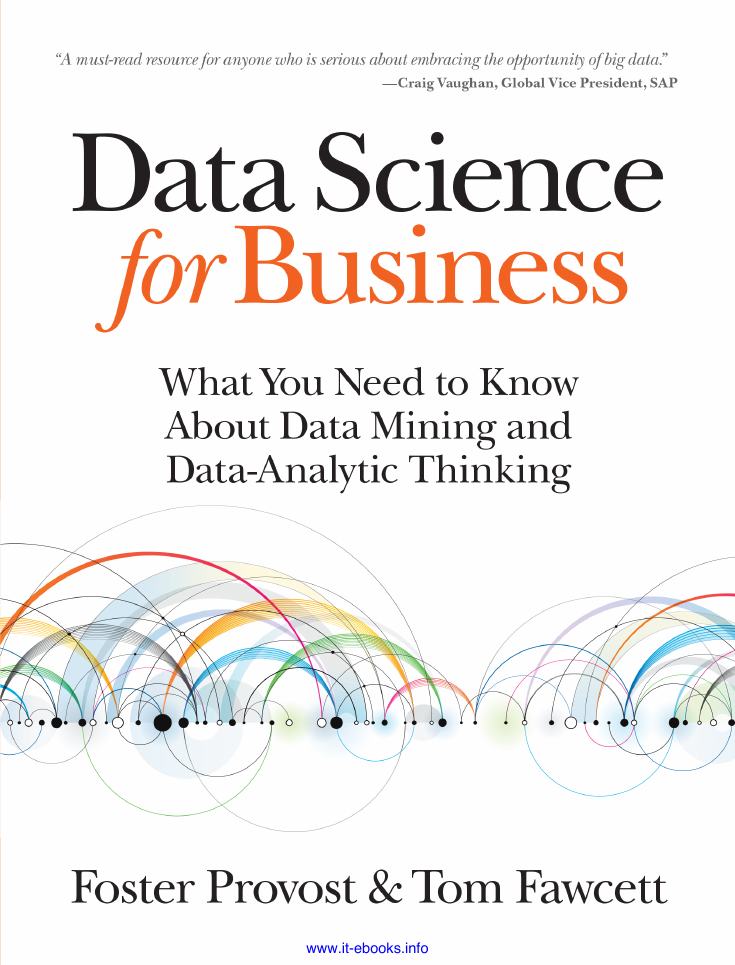
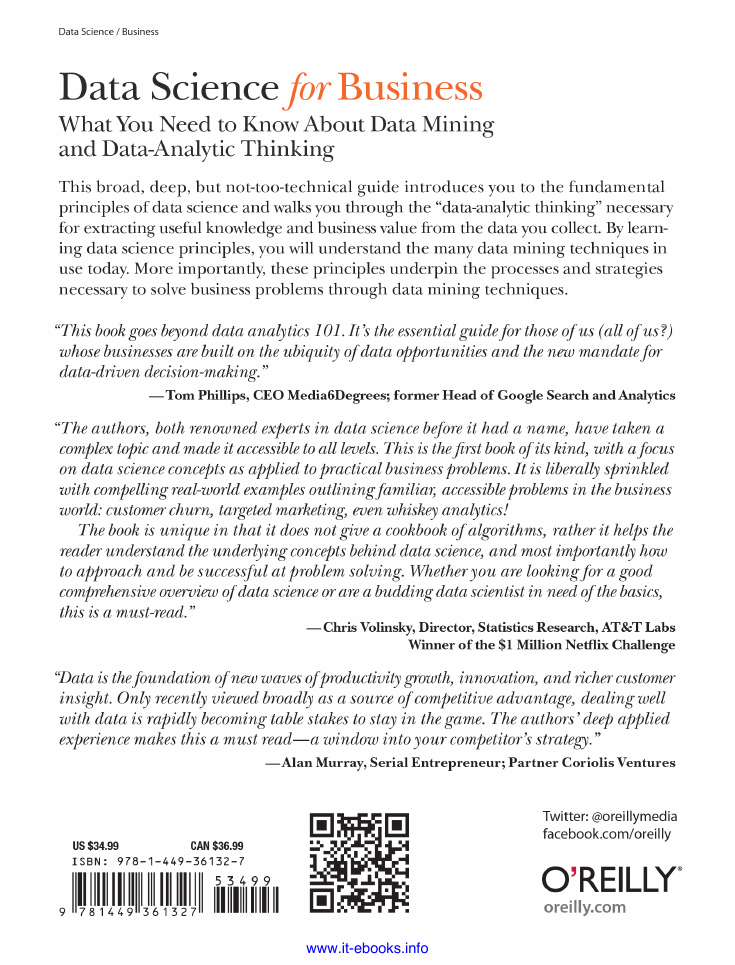
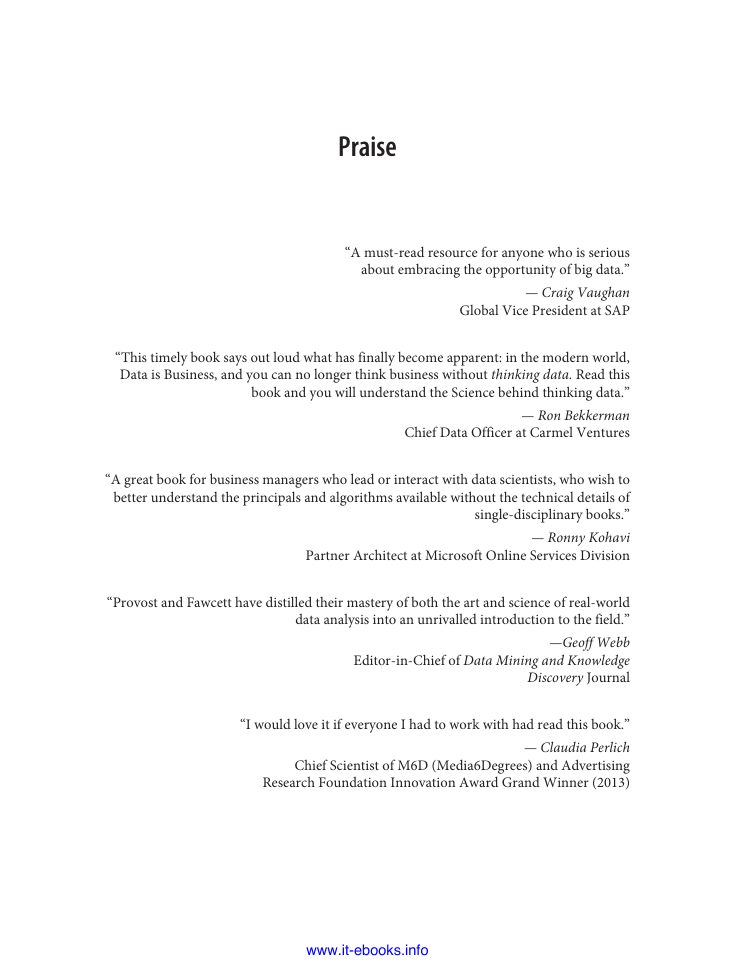
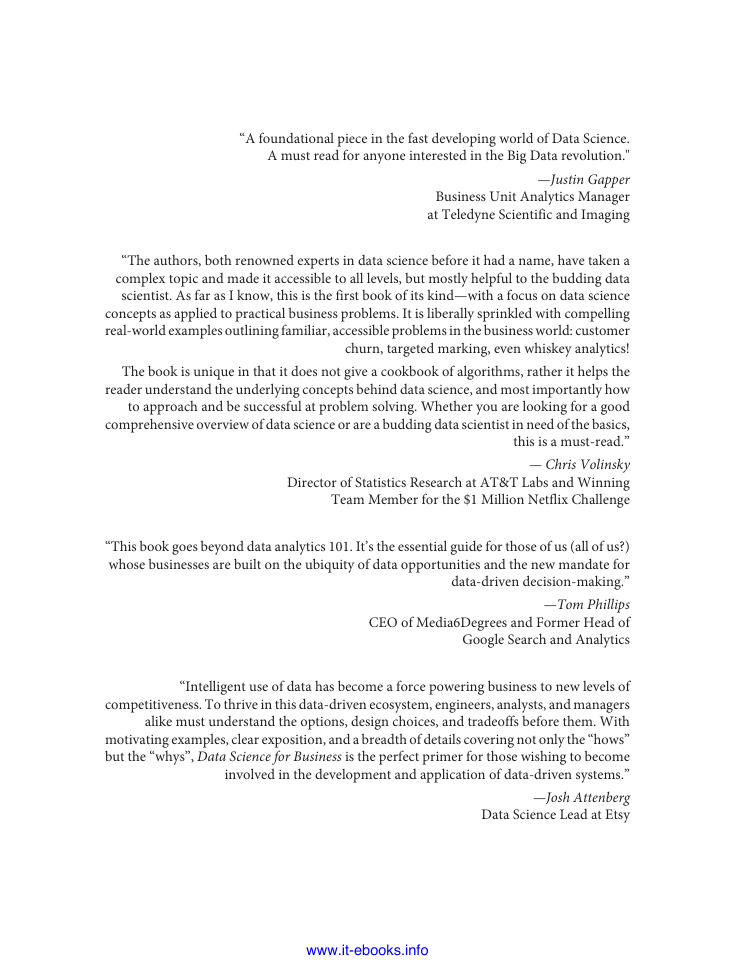
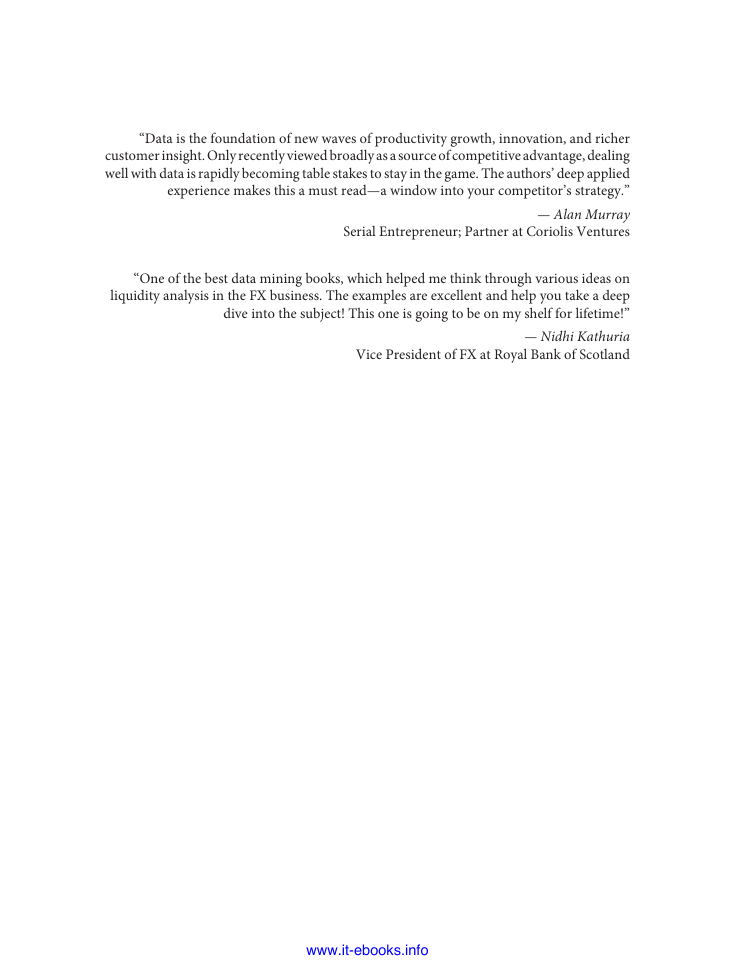

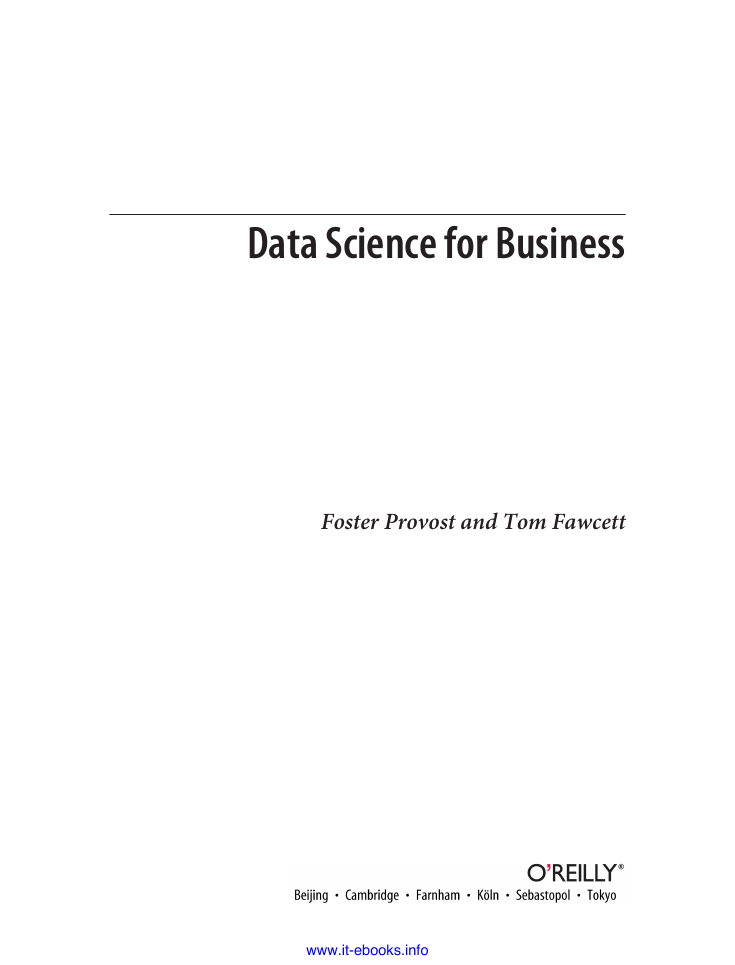
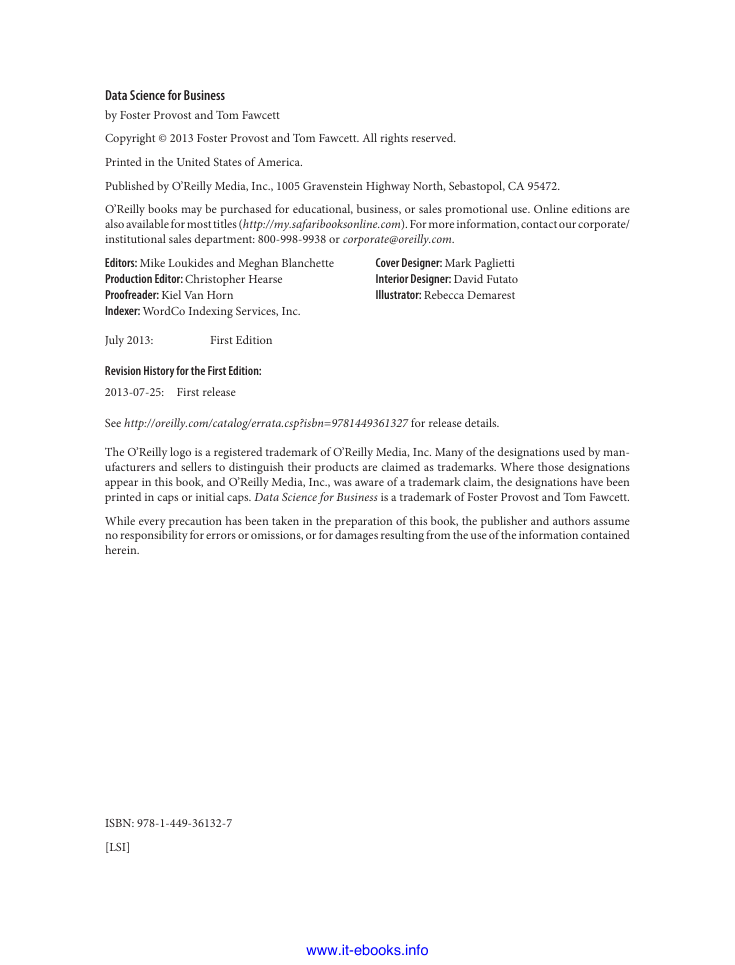








 2023年江西萍乡中考道德与法治真题及答案.doc
2023年江西萍乡中考道德与法治真题及答案.doc 2012年重庆南川中考生物真题及答案.doc
2012年重庆南川中考生物真题及答案.doc 2013年江西师范大学地理学综合及文艺理论基础考研真题.doc
2013年江西师范大学地理学综合及文艺理论基础考研真题.doc 2020年四川甘孜小升初语文真题及答案I卷.doc
2020年四川甘孜小升初语文真题及答案I卷.doc 2020年注册岩土工程师专业基础考试真题及答案.doc
2020年注册岩土工程师专业基础考试真题及答案.doc 2023-2024学年福建省厦门市九年级上学期数学月考试题及答案.doc
2023-2024学年福建省厦门市九年级上学期数学月考试题及答案.doc 2021-2022学年辽宁省沈阳市大东区九年级上学期语文期末试题及答案.doc
2021-2022学年辽宁省沈阳市大东区九年级上学期语文期末试题及答案.doc 2022-2023学年北京东城区初三第一学期物理期末试卷及答案.doc
2022-2023学年北京东城区初三第一学期物理期末试卷及答案.doc 2018上半年江西教师资格初中地理学科知识与教学能力真题及答案.doc
2018上半年江西教师资格初中地理学科知识与教学能力真题及答案.doc 2012年河北国家公务员申论考试真题及答案-省级.doc
2012年河北国家公务员申论考试真题及答案-省级.doc 2020-2021学年江苏省扬州市江都区邵樊片九年级上学期数学第一次质量检测试题及答案.doc
2020-2021学年江苏省扬州市江都区邵樊片九年级上学期数学第一次质量检测试题及答案.doc 2022下半年黑龙江教师资格证中学综合素质真题及答案.doc
2022下半年黑龙江教师资格证中学综合素质真题及答案.doc